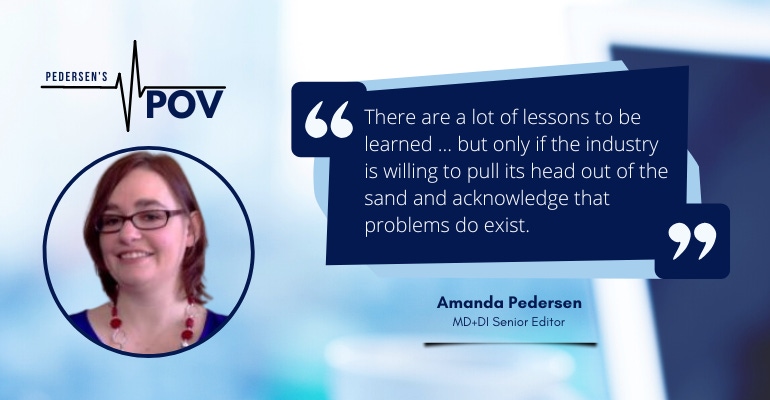Pedersen's POV: You Want Me to Write About What?
In this inaugural op-ed column, Senior Editor Amanda Pedersen shares her journey as a veteran medtech journalist, and touches on the good, bad, and ugly sides of the industry.
September 6, 2022

To the reader who stopped me at MD&M West a few years back and asked how I got into medtech journalism: Here’s the longer version of the answer I gave then, which was, “I sort of just fell into it.”
I was driving north on I-75 in Atlanta, GA about this time of year back in 2006 when I got a call about a job I didn’t even remember applying for.
“It’s like science and stuff,” the editor on the other end of the line explained (yes, he said “stuff”).
Having recently quit a "marketing job" that turned out to be a door-to-door pyramid scam, I was a bit skeptical of this unexpected interview offer. Trying to pay attention to traffic, I fumbled through a rather unprofessional response: “You want me to write about what?”
Still, who was I to turn my nose up at a potential job opportunity?
The medtech industry looks a lot different today than it did 16 years ago, thanks to mega mergers like Boston Scientific-Guidant, Medtronic-Covidien, BD-CareFusion, Abbott-St. Jude, and Zimmer-Biomet. Healthcare reform has also helped to transform the industry by driving the shift toward value-based care.
On the technology front, I’ve seen things like robotic surgery, 3D printing, and artificial intelligence become common place in medtech, and I’ve watched highly competitive sectors like liquid biopsy and transcatheter aortic valve replacement grow and thrive.
Since joining MD+DI in late 2016, I've also come to appreciate the broader ecosystem that medtech participates in, how advanced manufacturing trends impact that ecosystem, and the critical role of suppliers and distributors.
Unfortunately, while the industry has made many tremendous achievements in those 16 years, medtech is not immune to corporate greed. All too often I've reported on cases of fraud, kickback settlements, product safety issues that companies have tried to sweep under the rug instead of addressing them head on, and insider trading schemes.
There are a lot of lessons to be learned from these types of stories, but only if the industry is willing to pull its head out of the sand and acknowledge that problems do exist. Take The Bleeding Edge, for example. The Netflix documentary, which was released in July 2018, offered a poignant look at specific medical device categories that have adversely impacted patients.
The documentary should have been a learning opportunity for everyone working in medtech, and a catalyst for positive change. Instead, most people in the industry dismissed The Bleeding Edge as a smear piece. If it seemed like the film was one-sided, that's probably because the companies featured in it refused to speak with the filmmakers.
"We absolutely reached out to all of them, and we would have welcomed their participation in the documentary because we absolutely wanted to hear what they had to say, but we weren't surprised that they declined to participate," Kirby Dick, director of The Bleeding Edge, told me in a 2018 interview. "Historically, it seems like their M.O. is that when there's an issue, when someone is critiquing one of their devices, rather than make themselves available to the public or make themselves available to the press they often duck it, so it was not surprising that they did the same with us."
Dick said he was also surprised at the level of fear that medtech professionals seemed to have when approached.
"We've made many films about issues where people were afraid to speak because they were speaking about powerful institutions, but we've never come across an industry where people were as afraid to speak as they were about the medical device industry. That really surprised us," Dick said.
One MD+DI reader, a veteran in the medtech industry, did admit in our reader survey about The Bleeding Edge that there were some good takeaways in the film.
"Tons of lessons: 1) when an [adverse event] surfaces, don't rationalize it, don't brush it under the rug, use proper risk management to figure out what happened and correct it, the way the aviation industry does. 2) Don't succumb to the greed that pervades the industry today. Timelines for product pipelines are based as much on making money as they are on helping patients with needed technology. I know, I've spent 40 years as a serial entrepreneur in this industry. 3) Do let people know that the scenarios in this film are the exception to what is a very good (note that I didn't say excellent) safety record over the past 40 years. Don't hide from the debate – engage objectively and openly."

Pictured above is Ana Fuentes, an Essure patient featured in The Bleeding Edge. The film showed how the controversial birth control device caused a downward spiral of health problems that dramatically affected her personal and professional life.
This op-ed column, Pedersen's POV, was born from a desire to address all aspects of medtech – the good, the bad, and the ugly. Each week, I’ll address topics that are top of mind through a medtech lens. If there’s a topic that’s on your mind, email me at [email protected] (please put “POV” in the subject line).
About the Author(s)
You May Also Like




.png?width=300&auto=webp&quality=80&disable=upscale)